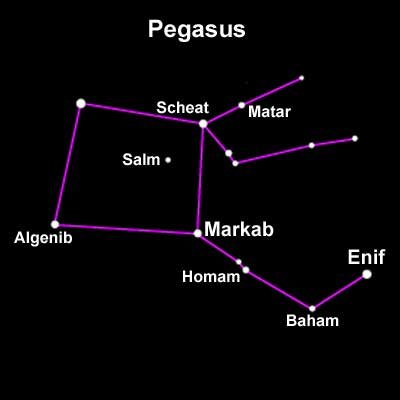The names of this month and the following ones need little imagination. There was a time when the Romans starting counting the year from the month when nature was re-born and the weather suitable for their military campaigns: MARCH. If we start counting from then, our actual month occupies the seventh position, hence SEPTEMBER.
The Milky Way moves slowly from the central part of the skies and everything begins to get darker. It’s the moment of the arrival of the Great Square of Pegasus, herald of Autumn, which this year will have its equinox on the 22nd., at around 10.45 p.m.
At 1.0 a.m. on the 2nd-3rd. Of September, between Villa del Campo and Guijo de Galisteo, at a little over two hands, is ALGENIB (the wing), one of the three stars of the Great Square (ch.12) – remember that the fourth belongs to Andromeda (ch. 11). Almost in the same location, but three and a half hands away, is SCHEAT (the shoulder), and at a little less than three hands, above Morcillo, we find MARKAB (the chair). In the distance, marking one of the farthest points of the constellation is ENIF (the nose), at three hands, between Coria and Casas de Don Gómez.
Above Pegasus, zig-zagging along the area between Torre de Don Miguel and Pozuelo de Zarzón, at about three and a half to four hands, we can see the constellation of LACERTA (the lizard), with its head in the Milky Way.
 We are going to relax our neck a little, as we have been stretching up to look for quite a while. The main star of Aquarius (ch. 13) is SADALMELIK (the king’s lucky man), at two and a half hands above Coria. To its left we can see with a “Y” shape the ANFORA of the Aguador, formed by SADACHBIA (the lucky one of hidden places), a little further down than Sadalmelik, and towards the left of
We are going to relax our neck a little, as we have been stretching up to look for quite a while. The main star of Aquarius (ch. 13) is SADALMELIK (the king’s lucky man), at two and a half hands above Coria. To its left we can see with a “Y” shape the ANFORA of the Aguador, formed by SADACHBIA (the lucky one of hidden places), a little further down than Sadalmelik, and towards the left of  Coria; ZETA-AQR, in the centre of the “Y”, almost at the same height, but above Rincón del Obispo; practically on top of it, but at the same height as Sadalmelik, is PI-AQR; and at the end of the tail of the “Y”, ETA-AQR, at the same height as Sadachbia and a little nearer Puebla de Argeme.
Coria; ZETA-AQR, in the centre of the “Y”, almost at the same height, but above Rincón del Obispo; practically on top of it, but at the same height as Sadalmelik, is PI-AQR; and at the end of the tail of the “Y”, ETA-AQR, at the same height as Sadachbia and a little nearer Puebla de Argeme.
The waters from the Anfora overflow onto Piscis Austrinus (ch. 14), whose principal star is FORMALHAUT (the fish’s mouth) at a little under a hand above Rincón de Obispo.
In many of our strolls through the skies we have used as a reference of observation the village of Santibañez el Alto. Today, from the stars, we send them a kiss...
And so until next month.








